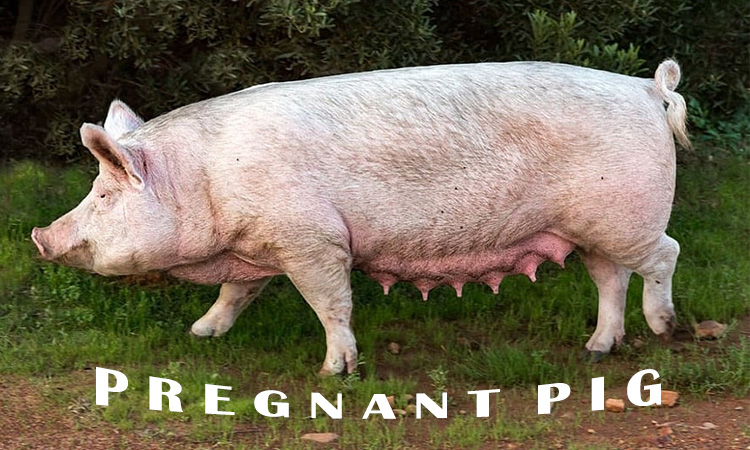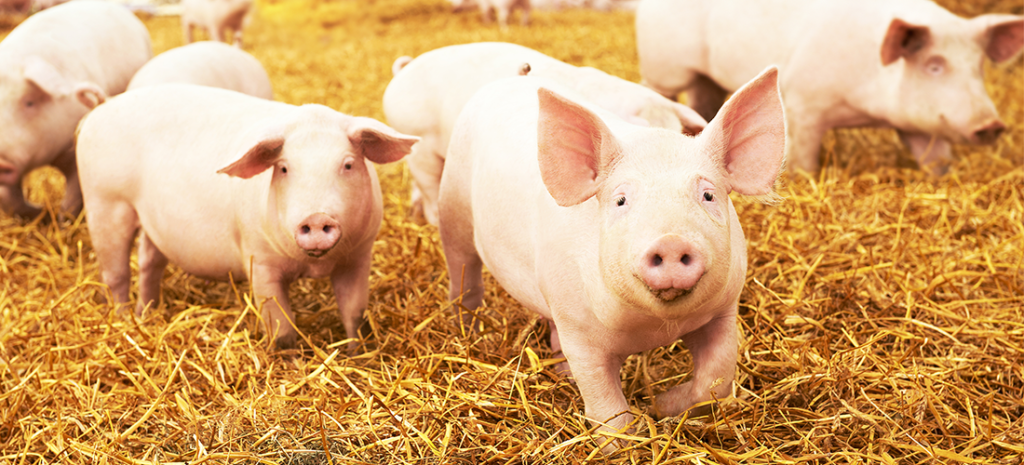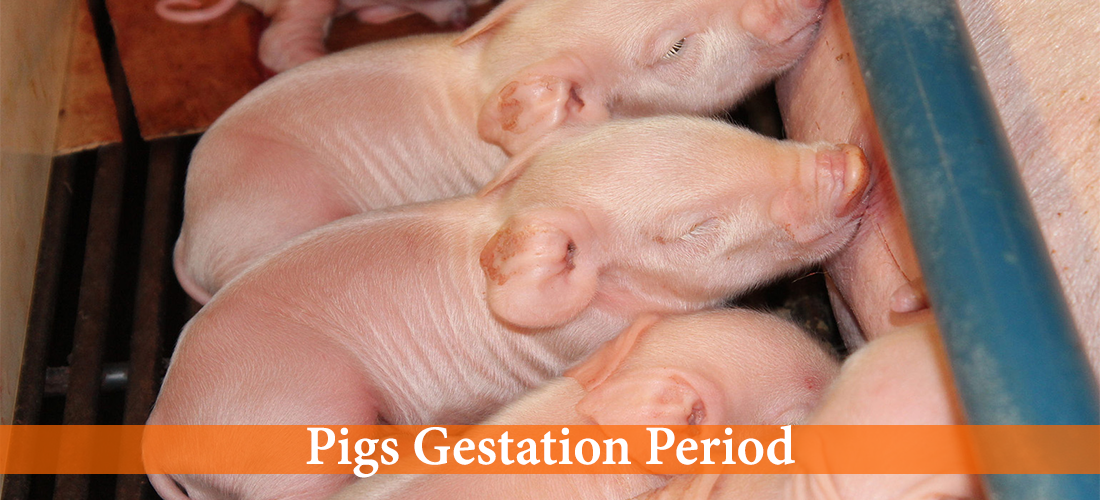Pig farmers and those interested in them must know the duration of a pig’s pregnancy. That way, it becomes possible to determine its period of gestation, signs that it is pregnant and variables that influence this condition.
This blog will look at different aspects of a pig’s gestation period among them things like factors affecting its length, signs of pregnancy, reproductive cycle, labor duration and pregnancy diagnosis pertain to traditional swine management systems in many countries.
What is the gestation period of Pigs?
There is an average 114-day period for which a pig carries its young ones; however, this may range from 112 days to 120 days due to various factors.
Pig Species and Their Gestation Period
The gestation periods for different types of pigs vary. For example, domesticated pigs have an estimated gestation period of about 114 days whereas miniature pigs have shorter gestations ranging around 112 days.
| Pig Species | Gestation Period |
|---|---|
| Domestic Pig | 112-120 days |
| Miniature Pig | 110-114 days |
| Wild Boar | 110-115 days |
| Pot-bellied Pig | 112-115 days |
| Yorkshire Pig | 114-118 days |
| Berkshire Pig | 114-118 days |
| Duroc Pig | 114-118 days |
| Hampshire Pig | 114-118 days |
| Landrace Pig | 114-118 days |
| Tamworth Pig | 114-118 days |
Factors Affecting the gestation period of Pigs
The gestation period refers to the time from conception to birth and it can be affected by several factors in pigs. Although an average pregnancy period for a pig is about 114 days (3 months, 3 weeks, and 3 days), there may be differences from this value due to different reasons.
Some factors affecting the gestation period of pigs:
Breed
Different breeds of pigs have slightly different lengths of pregnancy. However, while this average duration was estimated above, various breeds may have its variations. Breed-specific resources or consultants are therefore important for the most accurate details.
Individual Variations
Just as humans do, individual swine show differences in their reproductive processes. For instance, some pigs may naturally bear young ones after a shorter or longer time than is usual with normal deliveries. Consequently, these idiosyncratic dissimilarities influence the duration of pregnancies.
Litter Size
The size of the litter, which means the number of piglets a sow is carrying, can affect the gestation period. In most cases, bigger litters may slightly reduce the gestation period while smaller litters increase it.
Nutrition and Health
The pregnancy length is affected by the nutritional status as well as the general health condition of the mother pig. Proper care from veterinarians, the right weight gain and a nutritionally balanced diet are some ways through which optimal development of piglets is achieved and normal gestation maintained.
Environmental Factors
The pig gestation period could be influenced by environmental factors such as temperature and seasonality. In extreme temperatures or major changes in the environment may have an impact on the sow’s physiology and therefore the duration of gestation potentially.
Stress Levels
High levels of stress experienced by the sow during pregnancy can affect its term. Factors like overcrowding, noise or rapid change in surroundings can result in a prolonged pregnancy period due to stressful conditions.
Also Read - Fox Gestation Period, Learn about their pregnancy information, nutritional food during pregnancy and more.
How can you tell if a Pig is pregnant?
Determining whether or not a pig is pregnant means that there are several ways of doing so. One way is to go for a physical examination with a vet, which involves checking out the tummy area for any changes as well as mammary glands and behavior.
Additionally, fetuses can be detected through an ultrasound scan looking at the uterus and it’s very dependable. Moreover, during later stages, palpation of the belly manually can be used as also possible technique.
In this context blood tests detect pregnancy hormones such as relaxin in order to indicate earlier on that one is expectant. Lastly, watching out for behavior changes like nesting activities or increased appetite could sometimes give some hint about being pregnant.
It would be helpful, for instance, to consult with a Veterinarian who could confirm the pig was actually pregnant thus enabling appropriate steps to be made in breeding or other management decisions regarding it specifically
How many offspring do Pigs have?
The litter sizes borne by the sows differ as a result of factors including type of breed, age and condition of their health. 6 to 12 piglets is the average, but some pigs can produce up to 20 offspring.
Nonetheless, various factors like runts, stillbirths or even poor maternal care could lower the number of live births and piglet survival rate till weaning time. The size of a litter and the well-being of both the sow and her piglets may be influenced by proper nutrition, housing and management practices.
What Age Can Pigs Get Pregnant?
Gilts, the female pigs, can become pregnant and reach sexual maturity at 5 to 8 months of age depending on breed and individual development. However, for a breeder who wants gilts to be fully developed before they are allowed to reproduce, he or she will have to wait until that time when the young animals are between 8 and 9 months old.
This is because it might lead to different problems such as small litter size, difficulties in farrowing birth or even health challenges between gilt and piglets. In order to determine the appropriate age for breeding gilts proper management practices like monitoring growth and health must be observed.

How often can Pigs reproduce?
Like many other animals, pigs in most cases breed for reproduction more than once during their lifetime. In most cases, female pigs usually enter into an estrous cycle that can be termed as a heat cycle. This process allows the pig to conceive if a meeting takes place.
In the case of farrowing, sows normally experience postpartum estrus which implies that they can become ready for breeding after weaning off their offspring soonest possible time. To be able to give birth to a great number of offspring every year, boars and sows require adequate management practices such as nutrition, healthcare and breeding techniques thus increasing overall productivity levels of pork production.
Check Other Animal Gestation Periods Here
The Reproductive Cycle in Pigs
In pigs, the estrous cycle (also referred to as the reproductive cycle) has a number of distinct stages. Proestrus injects the beginning of the process that lasts for one to three days and is characterized by behavioral changes that indicate readiness for mating but no fertility yet.
Estrus otherwise known as ‘pigs in heat’ takes place over 2-3 days when the sow is fertile and shows receptive behavior. Towards the end of estrus ovulation usually occurs showing the highest level of fertility. There follows metestrus with only physiological changes in the repro tract after estrus.
Whilst metestrus occurs shortly after estrus and it involves some physiological alteration in the reproductive tract, diestrus is an extended phase lasting around fifteen to sixteen days that continues throughout pregnancy except where there is no fertilization. Effective comprehension and management of these phases are essential for improvement programs and maximizing productivity in pig farms through either natural breeding or artificial insemination methods.
How Long Are Pigs in Labor?
The period of farrowing in swine, or labor, can be influenced by factors such as her health status, the number of litters she has had before (parity) and the number of piglets delivered. It generally takes about 2 to 6 hours although it is not common for some sows to have 12 hours of labor time.
The size and position of unborn pigs within uterus uterine contractions among others may delay farrowing for the sow. Monitoring farrowing process very closely becomes an essential thing that a farmer should do in order to observe whether there is any progress being made between sows and their piglets since intervention is necessary whenever a problem arises.
Pig Pregnancy Diagnosis
Determining if a sow is pregnant through pig pregnancy diagnosis employs different techniques. One of these common approaches is using an ultrasound scanner to visualize the developing fetuses in the uterus. This method, therefore, has high accuracy and it can also detect early stages of insemination within 21 days.
Another method called palpation involves feeling the belly of a sow using hands thereby determining whether embryos or fetuses exist. Palpation, performed usually at about thirty days post-mating, provides a relatively accurate indication of pregnancy especially in its ensuing months. Blood tests are also available to detect relaxin and other similar hormones indicative of pregnancy, but their usage may not be as widespread as that of ultrasound and palpation tests.
Further, certain behavioral changes like reduced appetite or nesting behavior might indicate pregnancy though alone they cannot be used as definitive diagnostic methods for it in pigs. It is important for farmers to consult with their veterinary physicians for an authentic diagnosis before correctly managing pregnant sows during pig-rearing practices.
How Can I Tell if a Pig is Pregnant?
Detecting whether a pig is pregnant involves some methods. Ultrasound scanning which enables the vets to see the developing babies in the uterus is one such method. This technique is dependable and can confirm pregnancy as early as 21 days after mating. Another approach, palpation, entails touching the sow’s belly with hands to check if she has embryos or fetuses inside her.
Palpation is usually done around 30 days following mating and can give a relatively credible indication of pregnancy, especially during subsequent periods of gestation. Blood tests can also be performed to determine the existence of specific hormones that are related to pregnancy like relaxin even though these tests might not be commonly used compared to ultrasounds or palpation.
Alternatively, noting behavioral changes, for example, lessening appetite or resting conduct may imply conception but they do not stand out as ultimate diagnostic means for themselves alone. Therefore it is crucial for any pig farmer who wishes his sows to be accurately diagnosed about their pregnancy for adequate management purposes; hence should consult veterinary doctors regularly.
How Long After Giving Birth Can Pigs Be Spayed?
Spaying is the surgical removal of ovaries in female pigs which is usually done when piglets are several weeks old. However, it can slightly differ depending on factors such as the health of a piglet, advice from a veterinary doctor and conditions at the farm where the pig is being reared.
For some, this operation can take place immediately after birth while for others it may be delayed until weeks or months after their birth. Usually, it’s important to wait for the complete recovery of the piglet from parturition and gain enough strength to safely undergo surgery.
It is recommended to consult an experienced veterinarian dealing with pigs on how best to time spaying in order to ensure proper health condition and safety of the animal.

Care and Nutrition for a Pregnant Pig
In facilitating the good health and happiness of a pregnant sow, it is important to take into consideration some vital elements. One such element is ensuring that there is food with good ingredients for gestation and lactation period which has been well prepared according to the pig’s dietary needs.
At this point, feed consumption has to increase gradually while keeping an eye on the body condition of the sow in order to modify feeding rates as wanted.
Hydration is very important thus always supply clean fresh water. Besides, keep a comfortable and clean environment with appropriate housing and enough space that minimizes stress and reduces injury risks. Regular veterinary check-ups that involve prenatal care such as ultrasound scanning help in monitoring the sows’ wellbeing as well as detecting problems at an early stage.
Create a calm environment by avoiding stressful things during the pregnancy period. Lastly, prepare a farrowing area that is clean and well-bedded with nesting materials that will take care of the sow during the parturition process then see to it that all newborn pigs become warm and cozy after delivery. By considering these aspects of care and nutrition you can optimize the healthiness and productivity of the pregnant sow’s offspring
Also Read this post - Learn about Kangaroo Gestation Period with information about their Pouch.
FAQs
What is the pig’s gestation period?
The pigs typically gestate for about 114 days, although it is possible to be within 112 and 120 days.
Which factors affect the duration of pregnancy in pigs?
The length of pregnancy can be influenced by breed type, genetics, nutrition, environment and individual variation.
How long does labor last for Pigs?
Duration of parturition varies from 2-8 hours depending on different aspects such as number of young ones borne and what happens before birth process starts.
Why is proper nutrition important for pregnant Pigs?
Good food during this time ensures that both the pig being carried and its offspring remain healthy. This fosters fetal development, and lactation by sows, as well as leading to successful reproduction in general.
Conclusion
For the pig farmers, pig rearers and people in the business of keeping pigs it is important that they know the period of pig’s gestation for them to be successful. The discussion on this blog has looked at several issues with regard to pig pregnancy such as gestation length, signs of pregnancy, factors that influence duration and ways of diagnosing pregnancy.
There are variations in the duration of gestation among different breeds of pigs and it can be affected by some factors including several litters per species, breed differences, nutrition, individual differences and stress levels as well as environmental conditions.
During pregnancy, the health and welfare of the pregnant sow depend on her receiving proper care and nutritional requirements. The use of appropriate management practices while at the same time consulting with veterinarians will optimize reproductive performance and productivity hence contributing to successful pig farming operations among other benefits.

